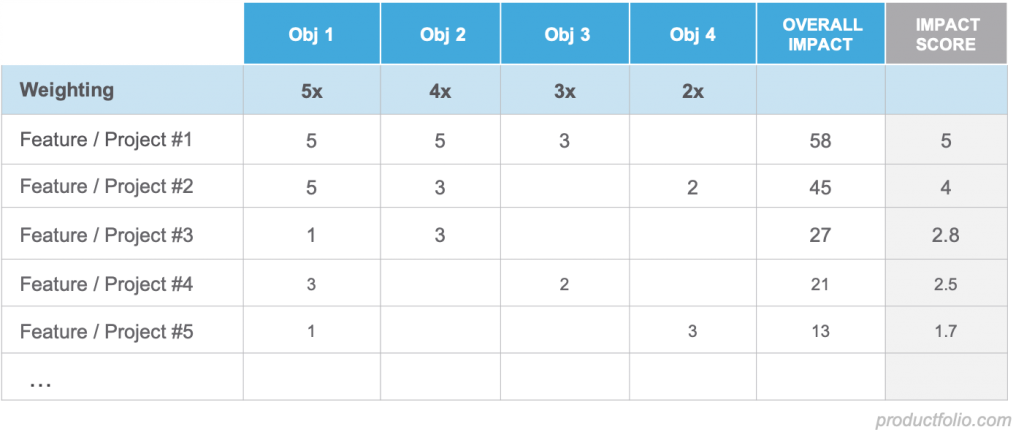What is Weighted Impact?
Weighted impact scoring is a standard framework for prioritizing your product roadmap. The framework entails ranking several features on various criteria using a benefit-versus-cost analysis. One of the most challenging aspects of a Product Manager’s job is determining which features will become a part of the product, and which features will wither away on the backlog. The Weighted Scoring framework helps Product Managers to prioritize each feature with a simple scoring method.

Weighted Scoring by the numbers
The aim when using the weighted scoring model is to evaluate each competing opportunity on your list to help prioritize what will go on your roadmap. This is accomplished in four simple steps, using the example of buying a new laptop.
- Define your criteria – To define your criteria determine what goals you’re hoping to satisfy. For example, you might choose the following criteria:
- Conversion Rate
- Revenue Per Session
- Monthly Active Users (MAU)
- Assign a weight to your criteria – Decide what percentage best applies to each of your criteria based on your goals using a 1 – 100% scoring method. This will help you to determine which of the criteria is your top priority. Example:
- 50% – Conversion Rate
- 30% – Revenue Per Session
- 20% – Monthly Active Users (MAU)
Based on the percentages that are applied to the example, Conversion Rate is the most important criteria.
Now that you’ve determined the weight for each of your criteria, it’s time to look at your options. It’s best to keep it simple using a scoring method of 0 – 5 in this portion of the framework. The last and final step is to multiply the assigned weighted score by the number assigned to the criteria.
Weighted Scoring allows you to create a point system for each of your initiatives by effectively calculating a total value. With all of your opportunities receiving a weighted score, you’re able to prioritize which initiatives will make it on to your roadmap. The opportunities with the lowest score will get moved to the backlog.
Benefits and Drawbacks
There are a number of frameworks like The Kano Model, ICE and RICE that can be used by product managers to prioritize features and initiatives. Which framework to use is a subjective decision. The Kano Model, for example, rates features based on their necessity versus their ability to “delight” customers. RICE and ICE both have specific criteria that determine your score by which you determine the prioritization of your features.
The benefit of working with the Weighted Scoring Model is that you determine the criteria by which you will be generating your score, therefore making ideal when your goal is to prioritize against goals/objectives. The downside of working with the Weighted Scoring Model is that it’s so flexible that there’s not a standard for measuring previous or future scores. Since the criteria changes each time, so do the scores, making the Weighted Scoring Model the most flexible, and the least precise of the prioritization models.
Conclusion
Product Managers have a number of tools and prioritization models to choose from, and the best one for you will depend on the culture of your organization, your product management style, and the product. It’s worth noting however that Productfolio prefers Weighted Scoring – a variant of it is the basis of our prioritization tool.


